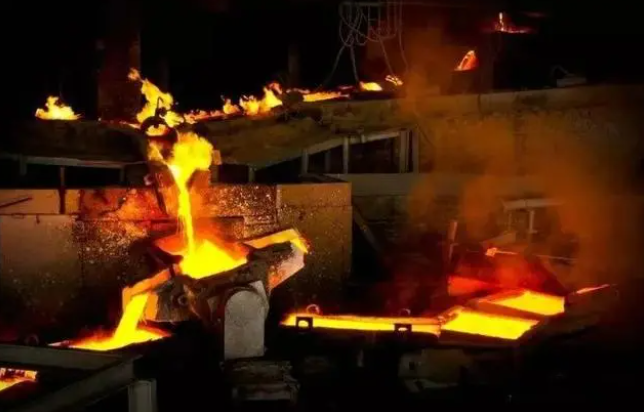Pyrometallurgical smelting
Fire refining is the main method of producing copper today, accounting for 80% to 90% of copper production, mainly for the treatment of sulfide ores. The advantages of pyrometallurgical copper smelting are strong adaptability of raw materials, low energy consumption, high efficiency, and high metal recovery rate. Copper smelting by fire can be divided into two categories: one is traditional processes, such as blast furnace smelting, reverberatory furnace smelting, and electric furnace smelting. The second is modern strengthening processes, such as flash furnace smelting and melt pool smelting.
Due to the prominent global energy and environmental issues since the mid-20th century, energy has become increasingly scarce, environmental protection regulations have become increasingly strict, and labor costs have gradually increased. This has led to the rapid development of copper smelting technology since the 1980s, forcing traditional methods to be replaced by new strengthening methods, and traditional smelting methods have gradually been phased out. Subsequently, advanced technologies such as flash smelting and melt pool smelting emerged, with the most important breakthrough being the widespread application of oxygen or enriched oxygen. After decades of effort, flash smelting and melt pool smelting have basically replaced traditional pyrometallurgical processes.
1. Fire smelting process flow
The pyrometallurgical process mainly includes four main steps: matte smelting, copper matte (matte) blowing, crude copper pyrometallurgical refining, and anode copper electrolytic refining.
Sulfur smelting (copper concentrate matte): It mainly uses copper concentrate to make matte smelting, with the aim of oxidizing some iron in the copper concentrate, removing slag, and producing matte with high copper content.
Matte blowing (matte crude copper): Further oxidation and slagging of matte to remove iron and sulfur from it, producing crude copper.
Fire refining (crude copper anode copper): The crude copper is further removed from impurities by oxidation and slagging to produce anode copper.
Electrolytic refining (anode copper cathode copper): By introducing direct current, the anode copper dissolves, and pure copper is precipitated at the cathode. Impurities enter the anode mud or electrolyte, thereby achieving the separation of copper and impurities and producing cathode copper.
2. Classification of pyrometallurgical processes
(1) Flash smelting
Flash smelting includes three types: Inco flash furnace, Outokumpu flash furnace, and ConTop flash smelting. Flash smelting is a smelting method that fully utilizes the huge active surface of finely ground materials to strengthen the smelting reaction process. After deep drying of the concentrate, it is sprayed into the reaction tower with oxygen-enriched air along with the flux. The concentrate particles are suspended in space for 1-3 seconds, and rapidly undergo oxidation reaction of sulfide minerals with high-temperature oxidizing airflow, releasing a large amount of heat, completing the smelting reaction, which is the process of matte production. The reaction products fall into the sedimentation tank of the flash furnace for sedimentation, further separating the copper matte and slag. This method is mainly used for matte smelting of sulfide ores such as copper and nickel.
Flash smelting began production in the late 1950s and has been promoted and applied in more than 40 enterprises due to significant achievements in energy conservation and environmental protection through continuous improvement. This process technology has the advantages of large production capacity, low energy consumption, and low pollution. The maximum copper ore production capacity of a single system can reach over 400000 t/a, which is suitable for factories with a scale of over 200000 t/a. However, it is required that the raw materials be deeply dried to a moisture content of less than 0.3%, concentrate particle size of less than 1mm, and impurities such as lead and zinc in the raw materials should not exceed 6%. The disadvantages of the process are complex equipment, high smoke and dust rate, and high copper content in the slag, which requires dilution treatment.
2) Molten pool melting
Melt pool smelting includes the Tenente copper smelting method, Mitsubishi method, Osmet method, Vanukov copper smelting method, Isa smelting method, Noranda method, top blown rotary converter method (TBRC), silver copper smelting method, Shuikoushan copper smelting method, and Dongying bottom blown oxygen rich smelting method. Melt pool smelting is the process of adding fine sulfide concentrate to the melt while blowing air or industrial oxygen into the melt, and strengthening the smelting process in a fiercely stirred molten pool. Due to the pressure exerted by the blowing air on the molten pool, the bubbles rise through the pool, causing the "melt column" to move, thus providing a significant input to the melt. Its furnace types include horizontal, vertical, rotary, or fixed, and there are three types of blowing methods: side blowing, top blowing, and bottom blowing.
Pool melting was applied in industry in the 1970s. Due to the good heat and mass transfer effects in the melting process of the molten pool, the metallurgical process can be greatly strengthened, achieving the goal of improving equipment productivity and reducing energy consumption in the smelting process. Moreover, the requirements for furnace materials are not high. Various types of concentrates, dry, wet, large, and powdered, are suitable. The furnace has a small volume, low heat loss, and good energy conservation and environmental protection. Especially, the smoke and dust rate is significantly lower than that of flash smelting.


 English
English Español
Español Português
Português русский
русский français
français 日本語
日本語 Deutsch
Deutsch Tiếng Việt
Tiếng Việt Italiano
Italiano Nederlands
Nederlands ไทย
ไทย Polski
Polski 한국어
한국어 Svenska
Svenska magyar
magyar Malay
Malay বাংলা
বাংলা Dansk
Dansk Suomi
Suomi हिन्दी
हिन्दी Pilipino
Pilipino Türk
Türk Gaeilge
Gaeilge عربى
عربى Indonesia
Indonesia norsk
norsk اردو
اردو čeština
čeština Ελληνικά
Ελληνικά Українська
Українська Javanese
Javanese فارسی
فارسی தமிழ்
தமிழ் తెలుగు
తెలుగు नेपाली
नेपाली Burmese
Burmese български
български ລາວ
ລາວ Latine
Latine Қазақ
Қазақ Euskal
Euskal Azərbaycan
Azərbaycan slovenský
slovenský Македонски
Македонски Lietuvos
Lietuvos Eesti Keel
Eesti Keel Română
Română Slovenski
Slovenski मराठी
मराठी Српски
Српски 简体中文
简体中文 Esperanto
Esperanto Afrikaans
Afrikaans Català
Català עִברִית
עִברִית Cymraeg
Cymraeg Galego
Galego 繁体中文
繁体中文 Latvietis
Latvietis icelandic
icelandic יידיש
יידיש Беларус
Беларус Hrvatski
Hrvatski Kreyòl ayisyen
Kreyòl ayisyen Shqiptar
Shqiptar Malti
Malti lugha ya Kiswahili
lugha ya Kiswahili አማርኛ
አማርኛ Bosanski
Bosanski Frysk
Frysk ជនជាតិខ្មែរ
ជនជាតិខ្មែរ ქართული
ქართული ગુજરાતી
ગુજરાતી Hausa
Hausa Кыргыз тили
Кыргыз тили ಕನ್ನಡ
ಕನ್ನಡ Corsa
Corsa Kurdî
Kurdî മലയാളം
മലയാളം Maori
Maori Монгол хэл
Монгол хэл Hmong
Hmong IsiXhosa
IsiXhosa Zulu
Zulu Punjabi
Punjabi پښتو
پښتو Chichewa
Chichewa Samoa
Samoa Sesotho
Sesotho සිංහල
සිංහල Gàidhlig
Gàidhlig Cebuano
Cebuano Somali
Somali Точик
Точик O'zbek
O'zbek Hawaiian
Hawaiian سنڌي
سنڌي Shinra
Shinra հայերեն
հայերեն Igbo
Igbo Sundanese
Sundanese Lëtzebuergesch
Lëtzebuergesch Malagasy
Malagasy Yoruba
Yoruba









